| Aug 24 – 25, 2024 | Cleveland-Berea Gun Show Held at Cuyahoga County Fairgrounds in Berea, OH and hosted by Ohio Shows Cleveland-Berea Gun Show |
| Aug 31, 2024 | Shelby County Gun Show Held at Shelby County Fairgrounds and hosted by River Valley Hunters Gun & Knife Show |
| Sept 7 – 8, 2024 | Medina Gun Show Held at Medina County Fairgrounds in Medina, OH and is hosted by Conrad & Dowell Productions |
| Sept 28, 2024 | Shelby County Gun Show Held at Shelby County Fairgrounds and hosted by River Valley Hunters Gun & Knife Show |
| Sept 28 – 29, 2024 | Maumee Valley Gun Show Held at Wood County Fairgrounds in Bowling Green, OH and hosted by Maumee Valley Gun Collectors. Maumee Valley |
| Oct 12 – 13, 2024 | Medina Gun Show Held at Medina County Fairgrounds in Medina, OH and is hosted by Conrad & Dowell Productions |
| Oct 26, 2024 | Shelby County Gun Show Held at Shelby County Fairgrounds and hosted by River Valley Hunters Gun & Knife Show |
| Nov 9 – 10, 2024 | Maumee Valley Gun Show Held at Wood County Fairgrounds in Bowling Green, OH and hosted by Maumee Valley Gun Collectors. Maumee Valley |
| Nov 9 – 10, 2024 | Medina Gun Show Held at Medina County Fairgrounds in Medina, OH and is hosted by Conrad & Dowell Productions |
| Nov 30, 2024 | Shelby County Gun Show Held at Shelby County Fairgrounds and hosted by River Valley Hunters Gun & Knife Show |
| Dec 14 – 15, 2024 | Medina Gun Show Held at Medina County Fairgrounds in Medina, OH and is hosted by Conrad & Dowell Productions |
| Dec 28, 2024 | Shelby County Gun Show Held at Shelby County Fairgrounds and hosted by River Valley Hunters Gun & Knife Show |
All posts by traderscreek
Marsh Marigold A Beauty with Dangers
As winter fades away and nature awakens, one can’t help but marvel at the colors and delicate blooms of our surroundings. Among the many spring flowers is the Marsh Marigold (Caltha palustris). With its vibrant yellow petals and lush green leaves, this lovely perennial is a true symbol of the changing seasons that can enchant any nature lover, but it is crucial to understand that this alluring beauty harbors a secret: it contains poisonous compounds.
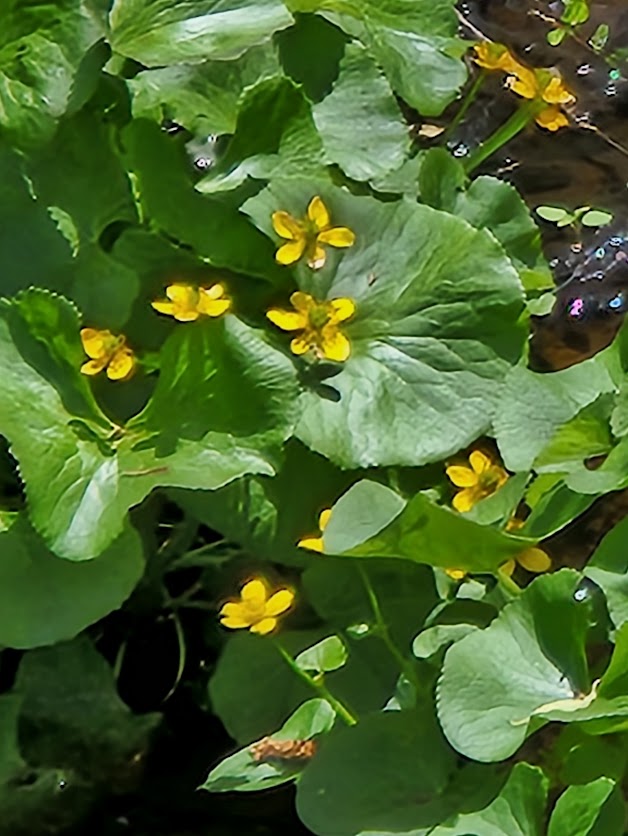
Common Names:
The Marsh Marigold goes by several common names across different regions. In addition to Marsh Marigold, it is often people refer to it as Kingcup due to the resemblance of its cup-shaped flowers to a royal chalice. Furthermore, Sometimes naturalists call it Cowslip of the Marsh, although it is distinct from the true Cowslip (Primula veris). These various names reflect the plant’s widespread popularity and recognition.
Description:
Marsh Marigold is known for its bright, golden-yellow flowers that bloom in early spring, typically between March and May, depending on the region. The flowers have a distinct cup shape with five to nine overlapping petals. They can reach a diameter of around 2 to 5 centimeters (0.8 to 2 inches). The glossy, dark green leaves of the Marsh Marigold are rounded or heart-shaped and are borne on long stalks emerging from the base of the plant. This perennial herb grows to a height of about 30 to 90 centimeters (12 to 35 inches).
Territory:
Marsh Marigold is native to Europe, Asia, and North America. In Europe, it can be found throughout the continent, from the British Isles to Scandinavia and down to the Mediterranean region. In Asia, its range extends from Siberia to Japan. In North America, Marsh Marigold is distributed across Canada and the northern United States, particularly in wetland areas.
Habitat:
Just like Cattails, Marsh Marigold thrives in wet and marshy habitats, displaying a preference for shallow water bodies such as ponds, ditches, swamps, and damp meadows. It is commonly found near streams and rivers, where it benefits from the constant moisture. The plant can tolerate partial shade but generally prefers full sun. Its adaptability to various soil types, including clay, loam, and sandy soils, contributes to its wide distribution.
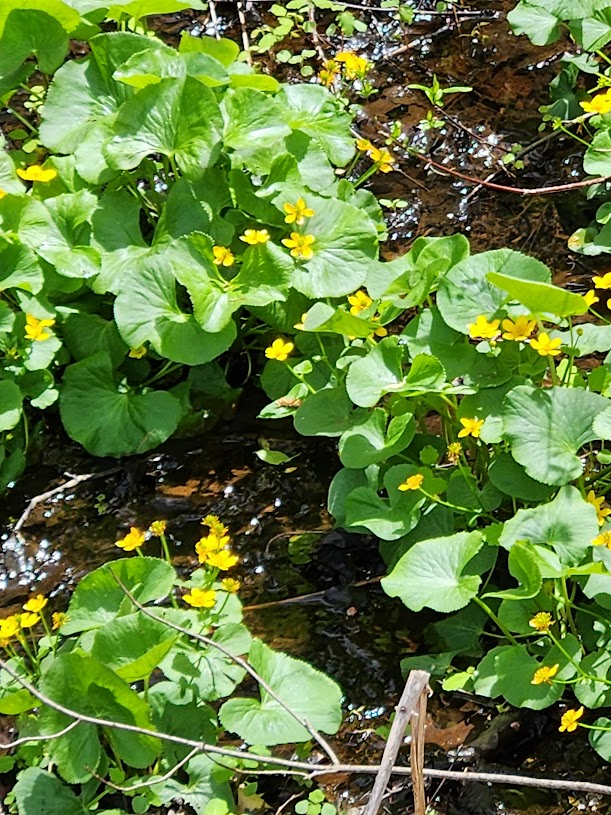
Poisonous Components:
The Marsh Marigold contains toxic compounds, primarily protoanemonin, which is a potent irritant. Protoanemonin is released when the plant is damaged or crushed, making it potentially harmful to humans and animals alike. While the entire plant contains varying levels of protoanemonin, the highest concentrations are typically found in the fresh leaves and stems. The roots and seeds also contain trace amounts of this toxic compound, albeit in smaller quantities.
Symptoms of Poisoning:
If the Marsh Marigold is ingested or comes into contact with the skin or eyes, it can lead to various symptoms of poisoning. These symptoms include blistering, skin irritation, redness, swelling, and burning sensations. Ingestion of the plant can cause nausea, vomiting, diarrhea, abdominal pain, and in severe cases, even respiratory distress. It is important to note that the intensity of the symptoms can vary depending on the individual and the amount of exposure to the toxic compounds.
Marsh Marigold Conservation Status:
The conservation status of the Marsh Marigold is a matter of concern. While it is not globally threatened, this species faces certain challenges, as does the broadleaf arrowhead, due to habitat loss and degradation. Wetland destruction, pollution, and invasive species pose significant threats to its survival. Additionally, over-harvesting for ornamental purposes can further impact the population of this plant in the wild. It is crucial to raise awareness about the importance of conserving wetland habitats and protecting the Marsh Marigold along with other flora and fauna that depend on these ecosystems.
Notes of Interest:
- Historical Uses: Despite its toxicity, Marsh Marigold has been utilized in traditional medicine for centuries. It was employed for treating various ailments such as skin conditions, rheumatism, and even as a diuretic.
- Symbolic Meaning: Marsh Marigold is often associated with rebirth and renewal. Its bright yellow flowers herald the arrival of spring, symbolizing hope, and new beginnings.
- Ecological Role: This plant plays a vital role in wetland ecosystems. Its flowers provide a valuable source of nectar for pollinators, while its foliage offers shelter for small aquatic organisms.
Marsh Marigold (Caltha palustris) is a captivating wetland plant that should be admired from a safe distance due to its poisonous nature. While it possesses a certain allure, caution should be exercised when encountering this plant to avoid any potential harm. Understanding its toxicity and taking steps towards preserving its habitat will ensure the continued existence of this species for future generations to appreciate.
Marsh Marigold Look-Alikes:
- Lesser Celandine (Ranunculus ficaria): One of the most common plants mistaken for marsh marigold is the lesser celandine. Both plants belong to the same family, Ranunculaceae, and share a similar yellow flower color. However, there are notable differences in their leaves and habitats. While marsh marigold thrives in wetland areas and has round, kidney-shaped leaves, lesser celandine prefers drier habitats and displays heart-shaped leaves. According to the Royal Horticultural Society (RHS), the two plants can sometimes be found growing alongside each other, contributing to the confusion (RHS).
- Kingcup (Caltha palustris var. radicans): Another plant closely related to the marsh marigold is the kingcup, which is a subspecies of Caltha palustris. Kingcup resembles marsh marigold so closely that the two are often considered synonymous. The primary difference lies in the habitat: while marsh marigold is found in marshes and wetlands, kingcup typically inhabits damp meadows and woodland areas. However, due to regional variations, the terms marsh marigold and kingcup are sometimes used interchangeably, leading to further confusion (Royal Botanic Garden Edinburgh).
- Globe Flower (Trollius spp.): Globe flowers, belonging to the Trollius genus, are often mistaken for marsh marigolds due to their similar appearance. Both plants share the characteristic yellow, buttercup-like flowers, and grow in similar habitats. However, globe flowers can be distinguished by their more rounded petals and taller stature compared to marsh marigold. The Royal Horticultural Society notes that globe flowers are commonly found in mountainous regions and prefer cool, moist conditions (RHS).
- Cowslip (Primula veris): Cowslips, while not as like marsh marigolds as the previously mentioned plants, can still occasionally be confused with them. Both species exhibit vibrant yellow flowers and bloom in early spring. However, cowslips have a more delicate appearance, with smaller flowers growing in clusters atop slender stems. Moreover, cowslips prefer drier habitats, often gracing meadows, and grasslands. In contrast, marsh marigolds favor wet and marshy areas (Wildlife Trusts).
Citations:
- Missouri Botanical Garden: Caltha palustris. Available at: https://www.missouribotanicalgarden.org/PlantFinder/PlantFinderDetails.aspx?kempercode=c177
- The Wildlife Trusts: Marsh-marigold.
- USDA Plants Database: Caltha palustris. Available at: https://plants.usda.gov/core/profile?symbol=CAPA8
- Royal Horticultural Society: Caltha palustris. Available at: https://www.rhs.org.uk/plants
- New Zealand Plant Conservation Network. (n.d.). Caltha palustris. Retrieved from https://www.nzpcn.org.nz/flora/species/caltha-palustris/
- Plants For A Future. (n.d.). Caltha palustris – L. Retrieved from https://pfaf.org/user/Plant.aspx?LatinName=Caltha+palustris
- Pouliot, M., & Chamberland, C. (2012). Poison
Broadleaf Arrowhead A Wetland Edible
Broadleaf Arrowhead A Wetland Edible
Introduction:
One of nature’s hidden treasures, the broadleaf arrowhead (Sagittaria latifolia), is an interesting . This wetland plant not only captivates us with its distinctive appearance but also its edible tubers, seeds, and young shoots. Join me as we delve into the realm of this edible plant.
Common Names:
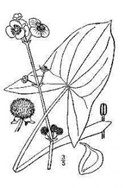 This versatile plant goes by several common names, each reflecting its various features and cultural significance. Among the most widely used names are “broadleaf arrowhead” and “duck-potato.” The term “arrowhead” is derived from the shape of its leaves, which resemble the tip of an arrowhead. Additionally, the name “duck-potato” is inspired by the fact that ducks and other waterfowl frequently feed on the plant’s tubers.
This versatile plant goes by several common names, each reflecting its various features and cultural significance. Among the most widely used names are “broadleaf arrowhead” and “duck-potato.” The term “arrowhead” is derived from the shape of its leaves, which resemble the tip of an arrowhead. Additionally, the name “duck-potato” is inspired by the fact that ducks and other waterfowl frequently feed on the plant’s tubers.
Description of the Plant:
The broadleaf arrowhead plant boasts a distinct appearance that makes it easy to identify and appreciate. Let’s dive into its key characteristics:
Foliage:
The arrowhead-shaped leaves, typically measuring 4” – 10” long, sprout on long stalks emerging from the water’s edge. The dark green leaves feature prominent veins and have a glossy texture. Their unique shape gives the plant its common name, “arrowhead.”
Flowers:
In the summer months, broadleaf arrowhead blooms with delicate white flowers that rise above the water’s surface on long, slender stems. These flowers exhibit three petals and a yellow center, adding a touch of elegance to the plant’s overall appearance. From August to October round clusters of seed casings develop.
Tubers:
Perhaps the most enticing feature of the broadleaf arrowhead lies beneath the water’s surface. The plant develops underground tubers, which are swollen, starchy structures that store nutrients and energy. These tubers can range in size from a few inches to over 5 inches in diameter. Their shape is elongated and somewhat reminiscent of a potato, hence the name “duck-potato.” These tubers serve as an excellent food source when foraging.
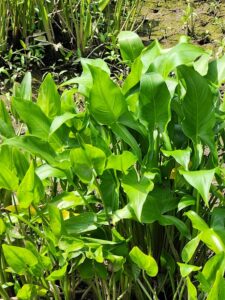
Territory:
The broadleaf arrowhead, like the cattail, is native to North America, where it can be found in a wide range of locations, including Canada, the United States, and Mexico. It thrives in both temperate and subtropical climates, allowing it to occupy a vast territory.
Habitat:
This versatile plant is predominantly found in wetlands, including marshes, ponds, lakes, and slow-moving streams where it can be found alongside pickerelweed. It demonstrates a remarkable adaptability to different water conditions, from shallow, still waters to those with a moderate current. The broadleaf arrowhead has even been known to establish itself in muddy or partially submerged areas, displaying its ability to colonize various habitats.
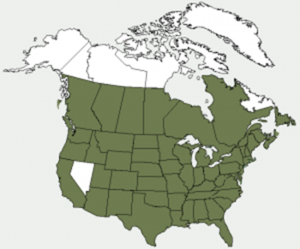
Edible Parts:
One of the most intriguing aspects of the broadleaf arrowhead is its edible nature. The plant offers several edible parts, including its tubers, young shoots, and seeds.
Tubers:
The tubers of the broadleaf arrowhead are the most harvested and consumed part. These underground, potato-like structures are rich in carbohydrates and offer a mild, nutty flavor. They can be harvested in late summer or early autumn when the plant’s energy is concentrated in the tubers.
Young Shoots:
The tender young shoots that emerge from the water are also edible. They can be harvested in spring and early summer and have a flavor like asparagus.
Seeds:
The seeds of the broadleaf arrowhead are small and can be ground into flour or used as a thickener in soups and stews. However, they are less commonly harvested compared to the tubers and shoots.
How to Harvest:
Harvesting broadleaf arrowhead requires some careful consideration to ensure sustainability and minimize ecological impact. Here are some guidelines to follow when harvesting:
Tubers:
To harvest tubers, gently loosen the soil around the base of the plant and carefully lift them from the mud. Select mature tubers, leave smaller ones for future plant growth and reproduction.
Young Shoots:
Harvest young shoots by cutting them close to the base of the plant. Choose shoots that are about 6 to 10 inches tall for optimal tenderness.
Seeds:
When collecting seeds, wait until the seed heads are mature and brown. Shake the seeds loose and separate them from the chaff by winnowing or using a sieve.
Cooking and Consumption:
Once harvested, the tubers can be cooked and enjoyed in various culinary applications. They can be boiled, roasted, mashed, or added to soups and stews, providing a nutritious and flavorful addition to your meals.
Young shoots can be eaten raw, added to salads, or steamed and boiled.
Seeds can be dried and ground into flour.
Conservation Status:
The conservation status of the broadleaf arrowhead is of concern in some regions due to habitat loss and degradation caused by human activities. Although it is not globally threatened, it is important to be mindful of the local regulations and guidelines regarding the harvesting of wild plants. It is advisable to obtain permission from landowners or consult with local conservation agencies before harvesting broadleaf arrowhead or any other wild edible plant.
Notes of Interest:
Indigenous peoples in North America historically relied on the broadleaf arrowhead as a food source and used it for medicinal purposes.
Some wildlife, such as waterfowl and beavers, also consume the broadleaf arrowhead, contributing to its ecological importance.
The Lewis and Clark expedition depended on the plant when they were in the Columbia River basin.
Know the Plant: Familiarize yourself with the characteristics of broadleaf arrowhead, paying special attention to its distinctive leaves and tubers, to ensure accurate identification.
The emergent foliage of this species provides cover for the same animals with the addition of fish and aquatic insects.
A single plant can annually yield up to 40 tubers.
Picture of plant: Robert H. Mohlenbrock @ USDA-NRCS PLANTS Database / USDA NRCS. 1992. Western wetland flora: Field office guide to plant species. West Region, Sacramento.
pokeberry poison plant
Pokeberry is a highly versatile plant with a wide range of uses. Although it is often considered a weed due to its rapid growth and invasive tendencies, it has also been used in traditional medicine for centuries. In addition to its medicinal properties, pokeberry is also used for food and dye. Due to its poison, I am not one to use this plant. I do not support medicinal use or culinary use, there are so many other wild plants I see no reason to mess with the pokeberry poison plant.
Common Names:
Pokeberry is known by several different common names, including poke, poke salad, inkberry, pigeonberry, and pokeberry weed.
Description:
Poke weed is an herbaceous perennial plant that can grow up to 10 feet tall under ideal conditions. The plant typically grows in disturbed areas such as fields, roadsides, and forest edges.
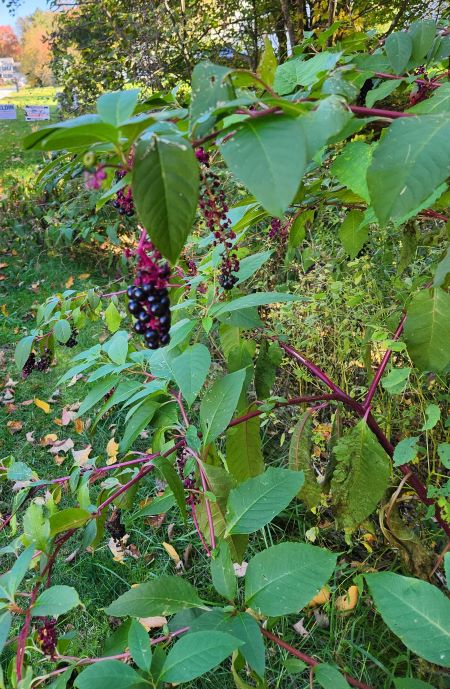
The leaves of poke weed are simple and alternate, with a length of 6 to 12 inches and a width of 2 to 6 inches. They are smooth and ovate, with a pointed tip and a smooth margin. The leaves are typically green but may take on a reddish or purplish tint as they mature.
The flowers of poke weed are small, white to greenish white in color, and are arranged in long, drooping clusters called racemes. The fruit of poke weed is a dark purple to black, juicy berry that is about the size of a pea. The berries contain a dark red juice that can stain skin and clothing.
Range:
Pokeberry is native to North America and can be found throughout the eastern and central regions of the United States.
Habitat:
It prefers moist, fertile soil and is commonly found in fields, pastures, and along roadsides.
Poison Part:
While the berries of pokeberry are edible when cooked properly, the plant is highly toxic and can be deadly if consumed in large quantities. The root, stem, leaves, and unripe berries contain high levels of toxins, including saponins and lectins. Pokeberry poison plant .
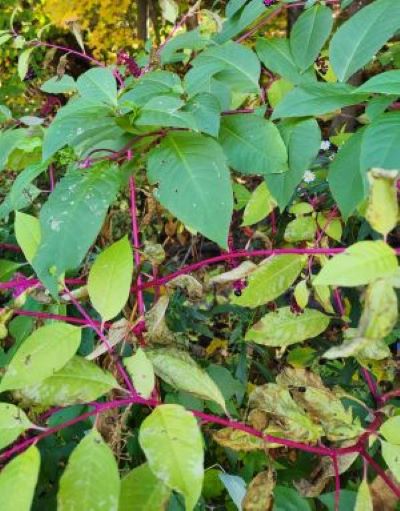
Symptoms of Poison:
Ingesting pokeberry can cause a wide range of symptoms, including nausea, vomiting, diarrhea, abdominal pain, and dehydration. In severe cases, it can lead to respiratory failure and death.
Conservation Status:
Pokeberry is considered a species of least concern by the International Union for Conservation of Nature (IUCN). It is a highly adaptable plant that can
thrive in a wide range of environments and is not currently threatened by extinction.
Notes of Interest:
In addition to its medicinal and culinary uses, pokeberry has also been used as a natural dye for textiles. The deep purple color of the berries can be extracted and used to dye fabric, yarn, and other materials.
Pokeberries should be handled with care due to the toxicity. It is important to properly cook any berries before consuming them and to avoid ingesting any other part of the plant. It’s important to note that while poke weed can be used for medicinal purposes, it is also toxic and can cause severe gastrointestinal distress if ingested in large amounts. With its versatility and unique properties, pokeberry remains an important plant in North American ecology and culture.
Back to poison plant index
Sources:
- “Phytolacca americana.” USDA Plants Database. https://plants.usda.gov/core/profile?symbol=PHAM
- “Phytolacca americana.” IUCN Red List of Threatened Species. https://www.iucnredlist.org/species/164220/1035237
- “Pokeberry: A North American weed with potential.” The Herbal Academy. https://theherbalacademy.com/pokeberry-a-north-american-weed-with-potential/
- “Pokeberry.” Missouri Botanical Garden. https://www.missouribotanicalgarden.org/PlantFinder/PlantFinderDetails.aspx?taxonid=279257&isprofile=0&cv=5&mobile=0&source=return&index=2
Red baneberry (Actaea rubra)
Red baneberry (Actaea rubra), a highly toxic plant, can be found throughout North America, Europe, and Asia. Despite its toxic properties, it is a popular ornamental plant due to its striking red berries and delicate white flowers. With that said, this is a plant that should be avoided if you have children or pets.
General Comments:
Red baneberry is a highly poisonous plant that can be fatal to humans and animals. It contains a toxin called protoanemonin, which can cause a wide range of symptoms when ingested, including vomiting, diarrhea, dizziness, seizures, and in severe cases, cardiac arrest. It is important to exercise caution when handling or consuming any part of this plant.
Common Names:
Red baneberry is also known by a variety of other common names, including red cohosh, doll’s eyes, snakeberry, and White Baneberry
Description:
Red baneberry is a perennial herbaceous plant that can grow up to 1 foot – 3 feet tall. It has delicate white flowers that bloom in late spring or early summer, which are followed by clusters of bright red berries. As the picture shows, leaves are alternate, 2 to 3 times compound, sharply toothed and lobed. The berries are about 1/8 inch in diameter and have a distinctive black “pupil” on each one, which gives them the appearance of doll’s eyes.
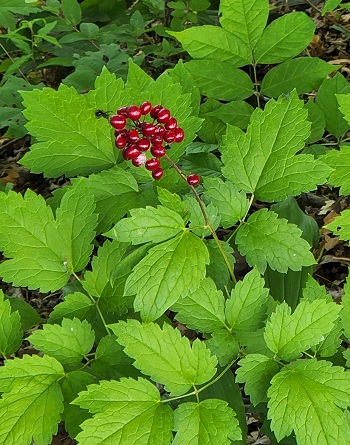
Territory:
Red baneberry is native to North America, Europe, and Asia. In North America, it can be found from Alaska to Newfoundland in the north, and from California to Georgia in the south. It is also found in parts of Europe and Asia, including Russia, China, and Japan.
Habitat:
The plant typically grows in moist, shady areas such as forests, meadows, and along stream banks. It prefers rich, loamy soil and is often found growing alongside other shade-loving plants such as ferns, wildflowers, and mosses.
Poison:
All parts of the plant are toxic, but the berries are the most poisonous. The leaves, stems, and roots also contain the toxin protoanemonin, but in smaller amounts.
Symptoms of Poison:
Ingesting any part of the red baneberry plant can cause a wide range of symptoms, including vomiting, diarrhea, dizziness, seizures, and in severe cases, cardiac arrest. Symptoms typically appear within 30 minutes to 2 hours of ingestion and can last for several hours. If you suspect that you or someone else has ingested red baneberry, seek medical attention immediately.
Conservation Status:
Red baneberry is not currently listed as endangered, but it is considered a species of concern in some parts of its range. Habitat loss and fragmentation are the primary threats to this plant, as it requires specific environmental conditions to thrive. Additionally, overharvesting of the plant for its ornamental value has contributed to its decline in some areas.
Notes of Interest:
Despite its toxicity, red baneberry has been used in traditional medicine to treat a variety of ailments, including rheumatism, fever, and snake bites. However, these uses are not supported by scientific evidence and should be avoided due to the plant’s poisonous properties.
Red baneberry is a highly toxic plant that should be handled with caution. Despite its toxic properties, it remains a popular ornamental plant due to its striking red berries and delicate white flowers. If you encounter this plant in the wild, admire it from a safe distance and do not attempt to handle or consume any part of it.
Sources:
• USDA Plants Database: Actaea rubra. (n.d.). Retrieved March 31, 2023, from https://plants.usda.gov/home/pl
Foraging for Nettle
Foraging for Nettle: A Nutritious and Sustainable Food Source
General Comments:
Among the many plants that can be foraged, nettle (Urtica dioica) is one that stands out for its versatility and abundance. Although often considered a weed, nettle has been used for centuries for food, medicine, and fiber. In this article, we will explore the various aspects of foraging for nettle, its description, territory, habitat, edible parts, how and when to harvest, conservation status, notes of interest and a nutrition chart based on studies from the USDA.
Common Names
Nettle is known by many names depending on the region and language. Some of its common names include stinging nettle, common nettle, giant nettle, devil’s leaf, and burn weed. The scientific name, Urtica dioica, derives from the Latin word “uro,” which means “to burn,” referring to the plant’s stinging hairs.
Description
Nettle is a perennial plant that can grow up to six feet tall. As can be seen in the picture, it has serrated, heart-shaped leaves that are covered with tiny, hollow stinging hairs that release histamine and other chemicals when touched, causing a painful (as some may say) rash. The stems are also covered with stinging hairs. The plant produces small, greenish flowers that are wind pollinated. Nettle is one of a very few plants that can be identified in total darkness – just walk thru a patch!!
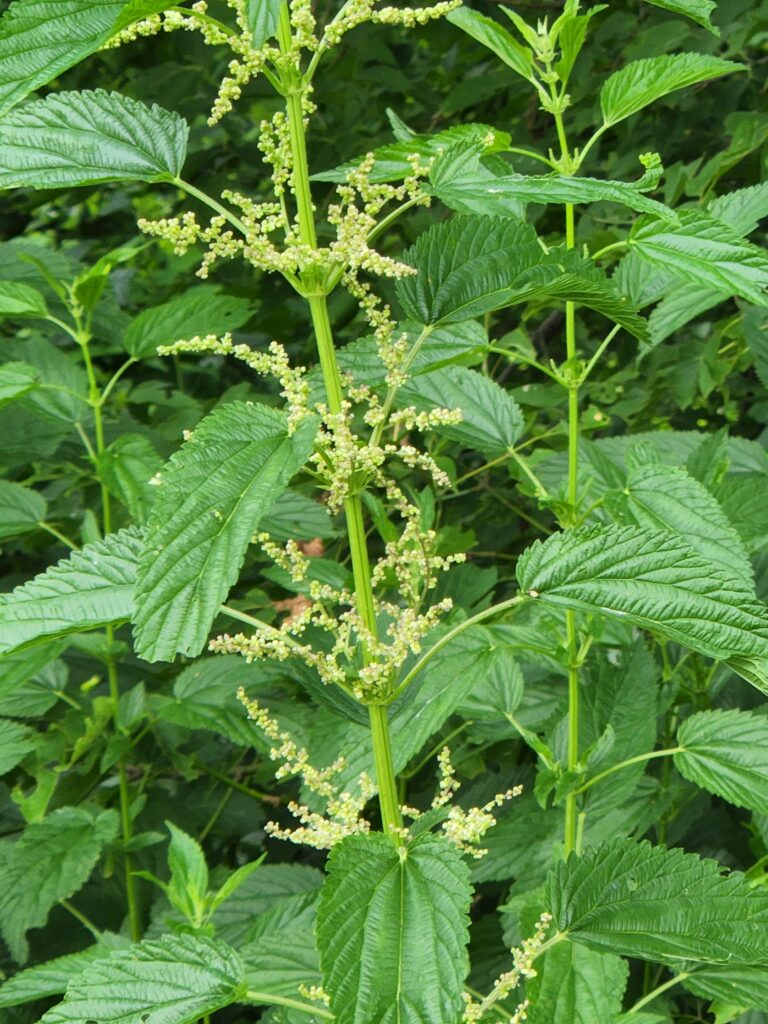
Territory
Nettle is native to Europe, Asia, and North Africa, but has been naturalized in many parts of the world, including North America, Australia, and New Zealand. It grows in temperate and tropical climates and can thrive in a variety of soil types.
Habitat
Nettle grows in a variety of habitats, including fields, forests, meadows, and disturbed areas such as roadsides and abandoned lots. It prefers moist, nitrogen-rich soil and can often be found near water sources. I have often found it near staghorn sumac and elderberry.
Edible Parts
Despite its reputation for causing painful rashes, nettle is a nutritious and versatile food source. The young leaves and shoots are edible and can be eaten raw or cooked. They are rich in vitamins A and C, iron, calcium, and protein. The leaves can be used in soups, stews, pesto, teas, and as a substitute for spinach in recipes. The roots can also be eaten and are said to have a nutty flavor.
How to Harvest
When harvesting nettle, it is important to wear gloves and long sleeves to avoid getting stung. The best time to harvest is in the spring when the young shoots and leaves are tender and before the plant flowers. Cut the leaves and stems with scissors or pruning shears and place them in a bag or basket. Be sure to only take what you need and leave enough for the plant to regenerate.
Conservation Status
Nettle is not currently listed as endangered or threatened, but its populations can be affected by habitat destruction, over-harvesting, and competition from invasive species. When foraging for nettle, it is important to do so sustainably and responsibly to ensure its continued availability.
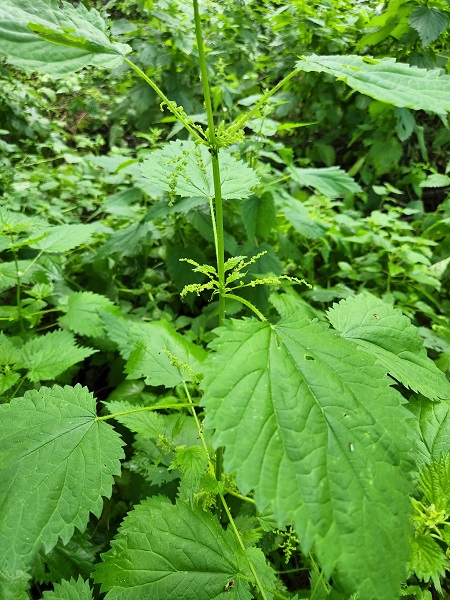
Notes of Interest
Nettle has been used for centuries for its medicinal properties, including treating arthritis, allergies, and urinary tract infections. It is also a popular ingredient in traditional herbal remedies and teas. Nettle has been used as a fiber source for clothing and textiles since ancient times and was even used to make fishing nets in medieval Europe.
Foraging for nettle can be a rewarding and sustainable way to obtain fresh, nutritious food. Despite its stinging hairs, nettle is a versatile plant that can be used in a variety of dishes and has many medicinal and cultural uses. When foraging for nettle, it is important to do so responsibly and sustainably to ensure its continued availability for others.